remote start Alfa Romeo 156 2006 Owner handbook (in English)
[x] Cancel search | Manufacturer: ALFA ROMEO, Model Year: 2006, Model line: 156, Model: Alfa Romeo 156 2006Pages: 357, PDF Size: 5.04 MB
Page 8 of 357
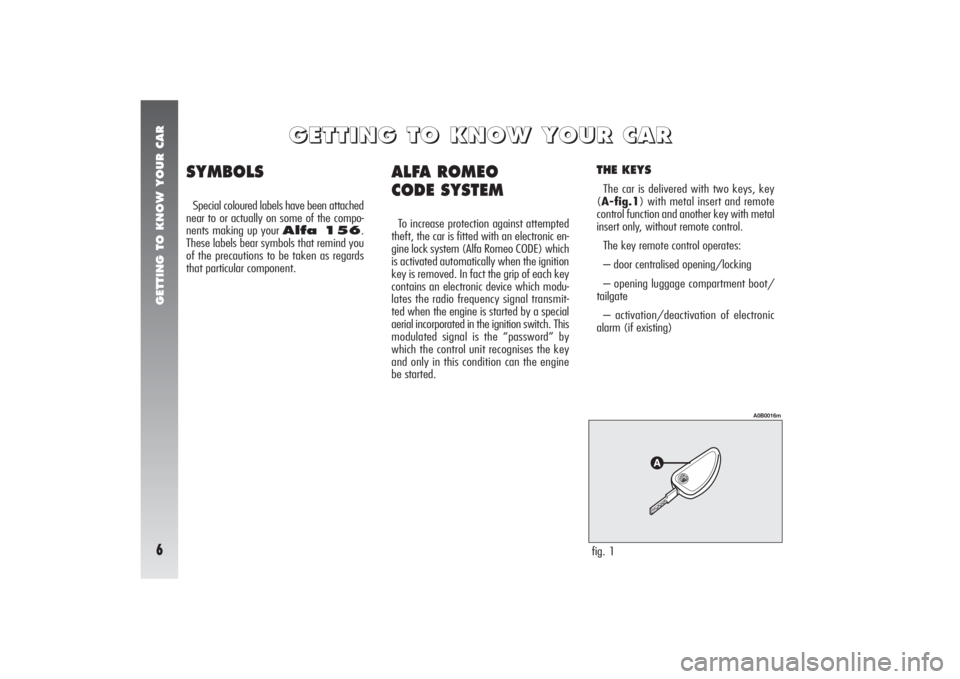
GETTING TO KNOW YOUR CAR6
ALFA ROMEO
CODE SYSTEMTo increase protection against attempted
theft, the car is fitted with an electronic en-
gine lock system (Alfa Romeo CODE) which
is activated automatically when the ignition
key is removed. In fact the grip of each key
contains an electronic device which modu-
lates the radio frequency signal transmit-
ted when the engine is started by a special
aerial incorporated in the ignition switch. This
modulated signal is the “password” by
which the control unit recognises the key
and only in this condition can the engine
be started.
THE KEYSThe car is delivered with two keys, key
(A-fig.1) with metal insert and remote
control function and another key with metal
insert only, without remote control.
The key remote control operates:
– door centralised opening/locking
– opening luggage compartment boot/
tailgate
– activation/deactivation of electronic
alarm (if existing)
G G
E E
T T
T T
I I
N N
G G
T T
O O
K K
N N
O O
W W
Y Y
O O
U U
R R
C C
A A
R R
SYMBOLSSpecial coloured labels have been attached
near to or actually on some of the compo-
nents making up your Alfa 156.
These labels bear symbols that remind you
of the precautions to be taken as regards
that particular component.
fig. 1
A0B0016m
Page 9 of 357
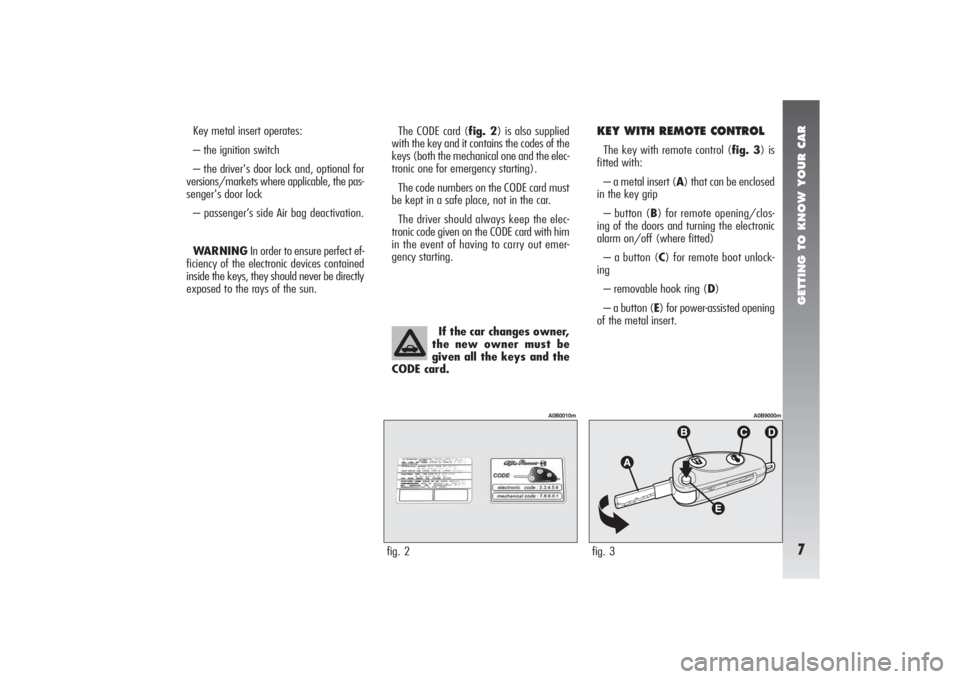
GETTING TO KNOW YOUR CAR7
Key metal insert operates:
– the ignition switch
– the driver's door lock and, optional for
versions/markets where applicable, the pas-
senger's door lock
– passenger’s side Air bag deactivation.
WARNINGIn order to ensure perfect ef-
ficiency of the electronic devices contained
inside the keys, they should never be directly
exposed to the rays of the sun.
If the car changes owner,
the new owner must be
given all the keys and the
CODE card.
fig. 2
A0B0010m
The CODE card (fig. 2) is also supplied
with the key and it contains the codes of the
keys (both the mechanical one and the elec-
tronic one for emergency starting).
The code numbers on the CODE card must
be kept in a safe place, not in the car.
The driver should always keep the elec-
tronic code given on the CODE card with him
in the event of having to carry out emer-
gency starting.
KEY WITH REMOTE CONTROLThe key with remote control (fig. 3) is
fitted with:
– a metal insert (A) that can be enclosed
in the key grip
– button (B) for remote opening/clos-
ing of the doors and turning the electronic
alarm on/off (where fitted)
– a button (C) for remote boot unlock-
ing
– removable hook ring (D)
– a button (E) for power-assisted opening
of the metal insert.fig. 3
A0B9000m
Page 15 of 357
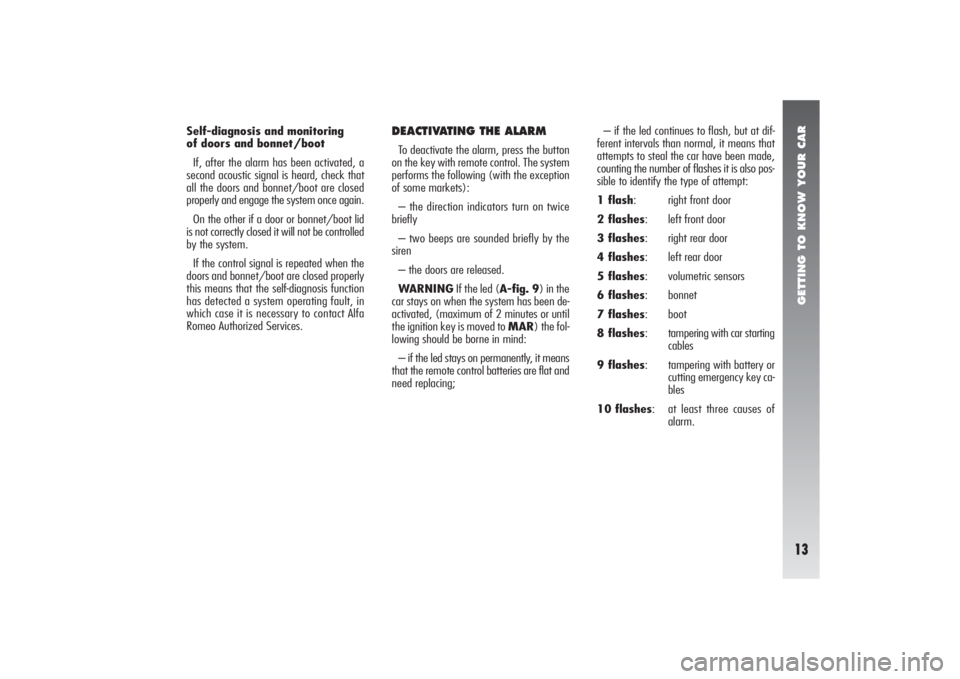
GETTING TO KNOW YOUR CAR13
Self-diagnosis and monitoring
of doors and bonnet/boot
If, after the alarm has been activated, a
second acoustic signal is heard, check that
all the doors and bonnet/boot are closed
properly and engage the system once again.
On the other if a door or bonnet/boot lid
is not correctly closed it will not be controlled
by the system.
If the control signal is repeated when the
doors and bonnet/boot are closed properly
this means that the self-diagnosis function
has detected a system operating fault, in
which case it is necessary to contact Alfa
Romeo Authorized Services.
DEACTIVATING THE ALARMTo deactivate the alarm, press the button
on the key with remote control. The system
performs the following (with the exception
of some markets):
– the direction indicators turn on twice
briefly
– two beeps are sounded briefly by the
siren
– the doors are released.
WARNINGIf the led (A-fig. 9) in the
car stays on when the system has been de-
activated, (maximum of 2 minutes or until
the ignition key is moved to MAR) the fol-
lowing should be borne in mind:
– if the led stays on permanently, it means
that the remote control batteries are flat and
need replacing;– if the led continues to flash, but at dif-
ferent intervals than normal, it means that
attempts to steal the car have been made,
counting the number of flashes it is also pos-
sible to identify the type of attempt:
1 flash: right front door
2 flashes: left front door
3 flashes: right rear door
4 flashes: left rear door
5 flashes: volumetric sensors
6 flashes: bonnet
7 flashes: boot
8 flashes: tampering with car starting
cables
9 flashes: tampering with battery or
cutting emergency key ca-
bles
10 flashes: at least three causes of
alarm.
Page 16 of 357
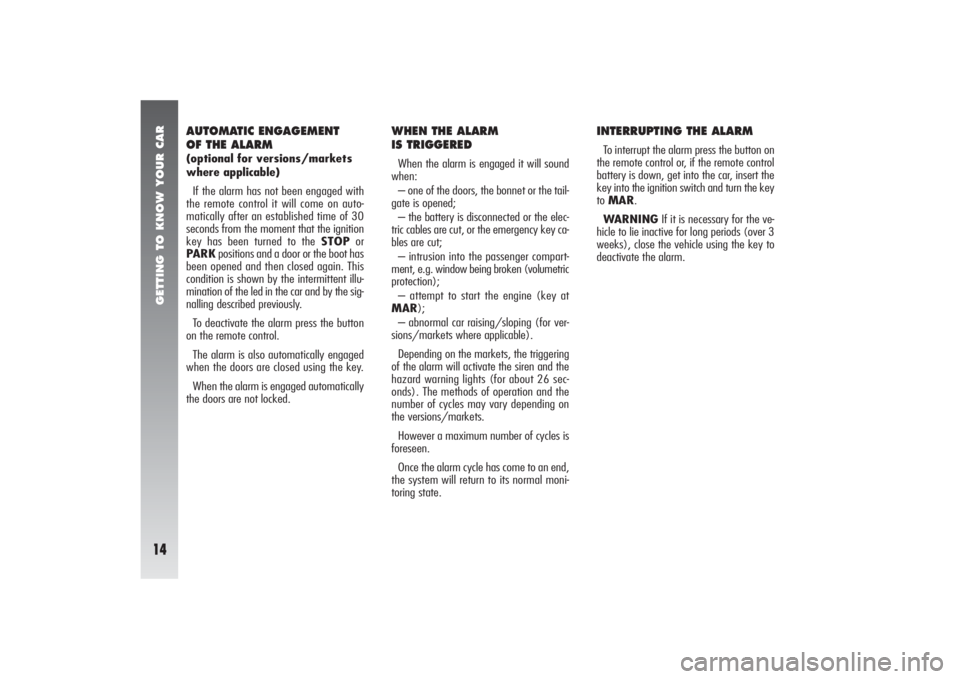
GETTING TO KNOW YOUR CAR14
AUTOMATIC ENGAGEMENT
OF THE ALARM (optional for versions/markets
where applicable)
If the alarm has not been engaged with
the remote control it will come on auto-
matically after an established time of 30
seconds from the moment that the ignition
key has been turned to the STOPor
PARKpositions and a door or the boot has
been opened and then closed again. This
condition is shown by the intermittent illu-
mination of the led in the car and by the sig-
nalling described previously.
To deactivate the alarm press the button
on the remote control.
The alarm is also automatically engaged
when the doors are closed using the key.
When the alarm is engaged automatically
the doors are not locked.
WHEN THE ALARM
IS TRIGGEREDWhen the alarm is engaged it will sound
when:
– one of the doors, the bonnet or the tail-
gate is opened;
– the battery is disconnected or the elec-
tric cables are cut, or the emergency key ca-
bles are cut;
– intrusion into the passenger compart-
ment, e.g. window being broken (volumetric
protection);
– attempt to start the engine (key at
MAR);
– abnormal car raising/sloping (for ver-
sions/markets where applicable).
Depending on the markets, the triggering
of the alarm will activate the siren and the
hazard warning lights (for about 26 sec-
onds). The methods of operation and the
number of cycles may vary depending on
the versions/markets.
However a maximum number of cycles is
foreseen.
Once the alarm cycle has come to an end,
the system will return to its normal moni-
toring state.
INTERRUPTING THE ALARMTo interrupt the alarm press the button on
the remote control or, if the remote control
battery is down, get into the car, insert the
key into the ignition switch and turn the key
to MAR.
WARNINGIf it is necessary for the ve-
hicle to lie inactive for long periods (over 3
weeks), close the vehicle using the key to
deactivate the alarm.
Page 164 of 357

GETTING TO KNOW YOUR CAR
162
CEILING LIGHTS The car is fitted with passenger’s com-
partment ceiling lights (front/rear) with
gradual switching on/off. Timings, defined
as max. switching on time elapsing between
the end of gradual switching on and the start
of gradual switching off are as follows:
1)approx. 6 seconds when:
– unlocking the doors manually or by the
remote control
– closing the driver’s door to get into the
car and fit the key into the ignition switch
– removing the key from the ignition
switch.
2)approx. 3 minutes from the door open-
ing.WARNING With ignition key at STOP
or when opening a door or the tailgate 15
minutes timing is activated, then ceiling
lights go off. Timing restarts each time a
door/tailgate is opened.
Front roof light (fig. 145)
The roof light comprises two lights with the
control switch.
With switch (A) in the central position
(1), both lights turn on when a door is
opened.
When the doors are closed, a timer is ac-
tivated for about 7 seconds, to allow the car
to be started. The lights go out when the ig-
nition key is turned to MAR(with the doors
closed).
Moving switch (A) to the left (position 0),
the lights stay off (position OFF).Moving switch (A) to the right (posi-
tion2) both lights stay on.
The spot function is operated by switch
(B).
Moving switch (B) to the left (position 1)
the left spot light turns on. Moving switch
to the right (position 2) the right spot light
turns on.
With switch (B) in the central position (po-
sition 0) the spotlights stay off.
WARNINGBefore leaving the car, make
sure that both switches are in the central po-
sition. This way, the roof lights will go out
when the doors are closed. If a door is left
open, the lights will go out automatically af-
ter a few seconds.
To turn them on again, simply open an-
other door or close the same one and open
it again.fig. 145
A0B0575m
Page 270 of 357
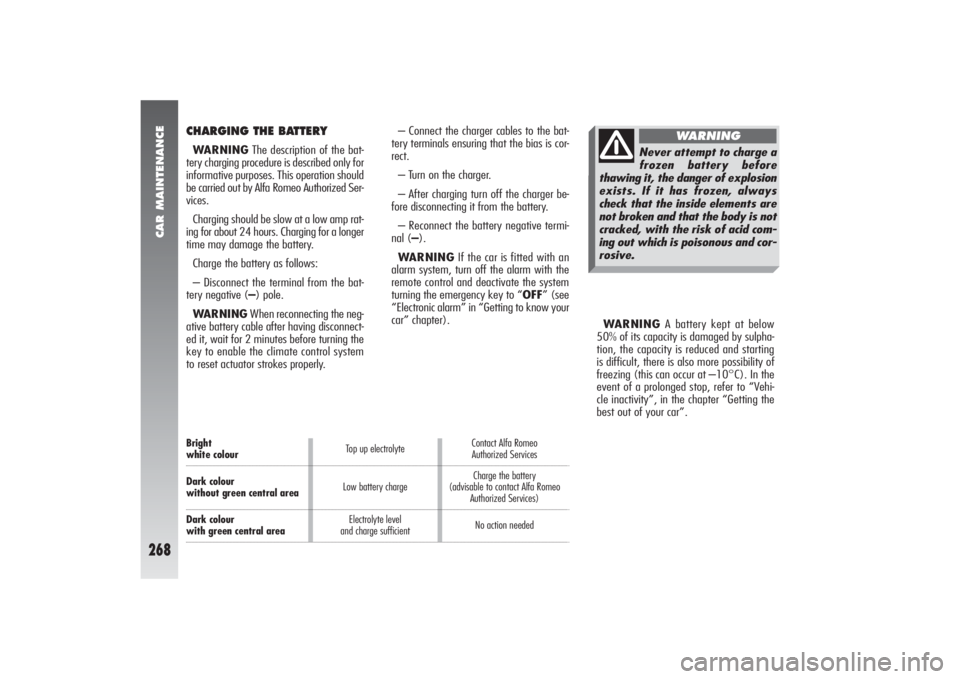
CAR MAINTENANCE
268
WARNINGA battery kept at below
50% of its capacity is damaged by sulpha-
tion, the capacity is reduced and starting
is difficult, there is also more possibility of
freezing (this can occur at –10°C). In the
event of a prolonged stop, refer to “Vehi-
cle inactivity”, in the chapter “Getting the
best out of your car”. – Connect the charger cables to the bat-
tery terminals ensuring that the bias is cor-
rect.
– Turn on the charger.
– After charging turn off the charger be-
fore disconnecting it from the battery.
– Reconnect the battery negative termi-
nal (–).
WARNINGIf the car is fitted with an
alarm system, turn off the alarm with the
remote control and deactivate the system
turning the emergency key to “OFF” (see
“Electronic alarm” in “Getting to know your
car” chapter).
Bright white colour
Dark colour without green central area
Dark colour with green central areaTop up electrolyte
Low battery charge
Electrolyte level
and charge sufficientContact Alfa Romeo
Authorized Services
Charge the battery
(advisable to contact Alfa Romeo
Authorized Services)
No action neededCHARGING THE BATTERYWARNINGThe description of the bat-
tery charging procedure is described only for
informative purposes. This operation should
be carried out by Alfa Romeo Authorized Ser-
vices.
Charging should be slow at a low amp rat-
ing for about 24 hours. Charging for a longer
time may damage the battery.
Charge the battery as follows:
– Disconnect the terminal from the bat-
tery negative (–) pole.
WARNINGWhen reconnecting the neg-
ative battery cable after having disconnect-
ed it, wait for 2 minutes before turning the
key to enable the climate control system
to reset actuator strokes properly.
Never attempt to charge a
frozen battery before
thawing it, the danger of explosion
exists. If it has frozen, always
check that the inside elements are
not broken and that the body is not
cracked, with the risk of acid com-
ing out which is poisonous and cor-
rosive.
WARNING
Page 328 of 357
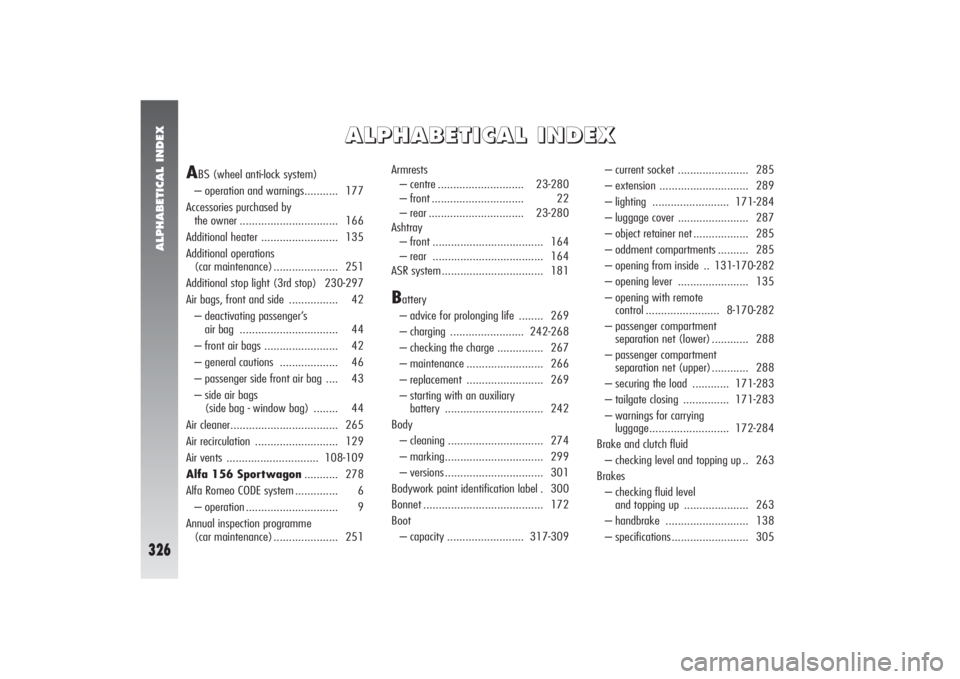
ALPHABETICAL INDEX
326
A A
L L
P P
H H
A A
B B
E E
T T
I I
C C
A A
L L
I I
N N
D D
E E
X X
A
BS (wheel anti-lock system)
– operation and warnings........... 177
Accessories purchased by
the owner ................................ 166
Additional heater ......................... 135
Additional operations
(car maintenance) ..................... 251
Additional stop light (3rd stop) 230-297
Air bags, front and side ................ 42
– deactivating passenger’s
air bag ................................ 44
– front air bags ........................ 42
– general cautions ................... 46
– passenger side front air bag .... 43
– side air bags
(side bag - window bag) ........ 44
Air cleaner................................... 265
Air recirculation ........................... 129
Air vents .............................. 108-109
Alfa 156 Sportwagon........... 278
Alfa Romeo CODE system .............. 6
– operation .............................. 9
Annual inspection programme
(car maintenance) ..................... 251Armrests
– centre ............................ 23-280
– front .............................. 22
– rear ............................... 23-280
Ashtray
– front .................................... 164
– rear .................................... 164
ASR system ................................. 181
Battery
– advice for prolonging life ........ 269
– charging ........................ 242-268
– checking the charge ............... 267
– maintenance ......................... 266
– replacement ......................... 269
– starting with an auxiliary
battery ................................ 242
Body
– cleaning ............................... 274
– marking................................ 299
– versions ................................ 301
Bodywork paint identification label . 300
Bonnet ....................................... 172
Boot
– capacity ......................... 317-309– current socket ....................... 285
– extension ............................. 289
– lighting ......................... 171-284
– luggage cover ....................... 287
– object retainer net .................. 285
– oddment compartments .......... 285
– opening from inside .. 131-170-282
– opening lever ....................... 135
– opening with remote
control ........................ 8-170-282
– passenger compartment
separation net (lower) ............ 288
– passenger compartment
separation net (upper)............ 288
– securing the load ............ 171-283
– tailgate closing ............... 171-283
– warnings for carrying
luggage.......................... 172-284
Brake and clutch fluid
– checking level and topping up .. 263
Brakes
– checking fluid level
and topping up ..................... 263
– handbrake ........................... 138
– specifications ......................... 305
Page 330 of 357

ALPHABETICAL INDEX
328
Diesel filter ................................. 265
Dimensions ........................... 315-316
Dipped beam headlights
– aiming for left-hand/
right-hand driving ................... 178
– changing bulbs ..................... 224
– switching on ......................... 48
Direction indicators
– changing front bulbs ............... 223
– changing rear bulbs ................ 228
– changing side bulbs ................ 227
– switching on ......................... 49
Door mirrors.......................... 25-26
Doors
– centralized locking ................. 19
– child safety lock............... 20-279
– opening/closing
from inside ..................... 19-278
– opening/closing
from outside ................... 18-278
– remote control ....................... 7
– remote locking/unlocking ...... 16
Economy and environment-friendly
driving ..................................... 197
Electronic alarm system................. 11
– automatic engagement ........... 14
– cutting out the siren .............. 15
– description ............................ 11
– interrupting the alarm ............. 14
– ministerial homologation ........ 16
– request for additional
emote controls....................... 12
– switching off ........................ 13
– switching on ......................... 12
– volumetric protection ............. 15
– when the alarm is triggered ..... 14
Electronic control units ................. 270
Emergency starting ................ 191-205
– starting by inertia .................. 207
– starting with an auxiliary
battery ................................. 242
Engine
– identification codes................. 301
– marking ............................... 299
– specifications ......................... 302
Engine compartment
– bonnet ................................. 172
– cleaning................................ 276Engine coolant
– checking level and topping up .. 261
– temperature gauge
and warning light ................... 62
Engine lock system
(Alfa Romeo CODE) ................... 6
Engine oil
– checking level and topping up .. 257
– consumption ......................... 258
Environment
– economy and environment-
friendly driving....................... 197
– emission reducing devices . 187-188
– protecting emission
reducing devices .................... 198
– reducing running costs
and environment pollution ....... 195
– use of non-toxic materials........ 187
EOBD system............................... 182
First-aid kit ................................ 247
Fix&Go (quick tyre repair kit) ........ 212
Flashing main beam headlights ..... 49
Fluids and lubricants .................... 320
Front foglights
– adjustment............................ 177
– changing bulbs ..................... 225
– switching on.......................... 136
Page 333 of 357
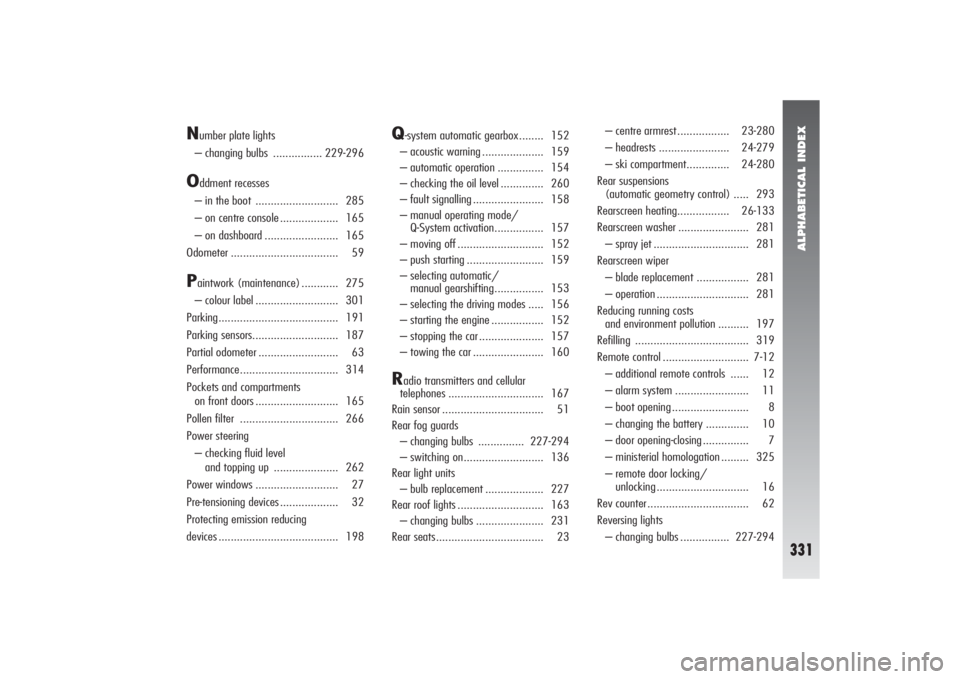
ALPHABETICAL INDEX
331
N
umber plate lights
– changing bulbs ................ 229-296
O
ddment recesses
– in the boot ........................... 285
– on centre console ................... 165
– on dashboard ........................ 165
Odometer ................................... 59
Paintwork (maintenance) ............ 275
– colour label ........................... 301
Parking....................................... 191
Parking sensors............................ 187
Partial odometer .......................... 63
Performance................................ 314
Pockets and compartments
on front doors ........................... 165
Pollen filter ................................ 266
Power steering
– checking fluid level
and topping up ..................... 262
Power windows ........................... 27
Pre-tensioning devices ................... 32
Protecting emission reducing
devices ....................................... 198
Q
-system automatic gearbox........ 152
– acoustic warning .................... 159
– automatic operation ............... 154
– checking the oil level .............. 260
– fault signalling ....................... 158
– manual operating mode/
Q-System activation................ 157
– moving off ............................ 152
– push starting ......................... 159
– selecting automatic/
manual gearshifting................ 153
– selecting the driving modes ..... 156
– starting the engine ................. 152
– stopping the car ..................... 157
– towing the car ....................... 160
R
adio transmitters and cellular
telephones ............................... 167
Rain sensor ................................. 51
Rear fog guards
– changing bulbs ............... 227-294
– switching on.......................... 136
Rear light units
– bulb replacement ................... 227
Rear roof lights ............................ 163
– changing bulbs ...................... 231
Rear seats................................... 23– centre armrest ................. 23-280
– headrests ....................... 24-279
– ski compartment.............. 24-280
Rear suspensions
(automatic geometry control) ..... 293
Rearscreen heating................. 26-133
Rearscreen washer ....................... 281
– spray jet ............................... 281
Rearscreen wiper
– blade replacement ................. 281
– operation .............................. 281
Reducing running costs
and environment pollution .......... 197
Refilling ..................................... 319
Remote control ............................ 7-12
– additional remote controls ...... 12
– alarm system ........................ 11
– boot opening ......................... 8
– changing the battery .............. 10
– door opening-closing ............... 7
– ministerial homologation ......... 325
– remote door locking/
unlocking .............................. 16
Rev counter................................. 62
Reversing lights
– changing bulbs ................ 227-294